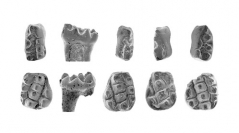

 Comptes Rendus Palevol
13 (6) - Pages 489-499
Comptes Rendus Palevol
13 (6) - Pages 489-499The Latest Cretaceous (Maastrichtian) terrestrial sedimentary sequences of the Haţeg Basin in Transylvania are well known for the so-called “Haţeg Island” vertebrate faunas, which evolved in endemic (insular?) conditions. In addition to frogs, lizards, turtles, crocodilians, birds and dinosaurs, peculiar multituberculate mammals have been recorded, all belonging to the family Kogaionidae. Here, a new species of the genus Barbatodon is reported from the Maastrichtian Şard Formation in the Transylvanian Basin (Alba County, Romania). Barbatodon oardaensis n. sp. is characterized by M1 cusp formula 3:4:2 and is much smaller than the two other Maastrichtian kogaionids from Transylvania, Barbatodon transylvanicus and Kogaionon ungureanui. The origin and paleobiogeography of kogaionids are discussed.
Multituberculates, Late Cretaceous, Transylvanian Basin, Haţeg Island, Paleobiogeography